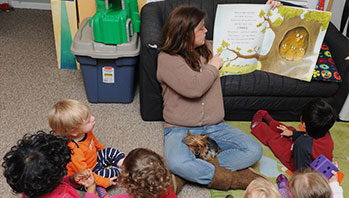-
pictures or books of real pigs in their environment
- different
- fantasy
- reality
- same
MA Standards:
Foundational Skills: RF.PK.MA.1 With guidance and support, demonstrate understanding of the organization and basic features of printed and written text: books, words, letters, and the alphabet.
Literature: RL.PK.MA.1 With prompting and support, ask and answer questions about a story or a poem read aloud.
Reading for Informational Text: RI.P.MA.7 With prompting and support, describe important details from an illustration or photograph.
Head Start Outcomes:
Literacy Knowledge/Book Appreciation and Knowledge Asks and answers questions and makes comments about print materials.
Logic and Reasoning/Symbolic Representation Recognizes the difference between pretend or fantasy situations and reality.
PreK Learning Guidelines:
English Language Arts/Reading and Literature 6 Listen to a wide variety of age appropriate literature read aloud.
English Language Arts/Reading and Literature 10 Engage actively in read-aloud activities by asking questions, offering ideas, predicting or retelling important parts of a story or informational book.
Read Together: The Three Little Pigs #2

© Commonwealth of Massachusetts, Department of Early Education and Care (Jennifer Waddell photographer). All rights reserved.
ELA Focus Skills: Listening and Speaking, Distinguishing Between Real and Make-Believe, Story Comprehension, Vocabulary
Before You Read
Display the pictures or nonfiction books of real pigs. Ask children what they know about pigs. Then ask, How are these pigs in the pictures different from the pigs in the book? Discuss the difference between real and make-believe. Say, On the first page I notice that the mother pig is standing by the fence in a dress with tears falling from her eyes. I don’t think real pigs wear dresses or stand up and cry and wave goodbye. Do you see anything else on these two pages that makes you think this story is make-believe?
Do a picture walk of the book for children. Ask children to point out things in the illustrations that show the pigs are not real. If children have difficulty finding things in the book, give them examples such as,
- On the spread where the pig got up at five, say, Do you think a pig would carry vegetables in a basket? What else do you notice that shows you the pig is not a real pig?
- On the last spread, say, I don’t think real pigs have fireplaces to cook over. What else do you notice that shows you he is not a real pig? (cooking, wearing an apron, standing on a stool)
Set a listening focus for children by asking them to look and listen for things that show the folktale is not about real pigs but that it’s a make-believe story.
As You Read
Read slowly and with expression. Hold the book so everyone can see the pages as you read. Pause on the spread where the pig meets the man with the straw. Say,
- This pig wants the straw to build a house. I wonder if that will be a strong house. What do you think?
- What is similar about the way the pig is building his house and the way the workers were building the house in the book Building a House? Have you ever seen a real pig building a house?
Pause on the page where the pig is reading in front of the fire. Ask, What do you notice in the picture that shows you the story is fantasy, or make believe? (pig reading a book, pig family pictures hanging on the wall)
Read the rest of the story without pausing to ask questions. Use gestures, facial expressions, body language, and illustrations to clarify unfamiliar words for children such as angry, blazing, boiled, bundle, churn, threw, and turnips.
After You Read
Remind children that The Three Little Pigs is a fantasy story about make-believe pigs. Discuss with children the fantastical elements of the story, for example, pigs talking, cooking, and building houses; wolf climbing up to a chimney and going down the chimney, etc.
Educator Tip: This version of the classic tale has the wolf eating the little pigs. Be sensitive to children who might be fearful or have suffered losses in their lives. Share a different version with them.
English Language Learners: Point out the pronunciation similarities between the English and Spanish words version/versión to bridge understanding of the new vocabulary word.
